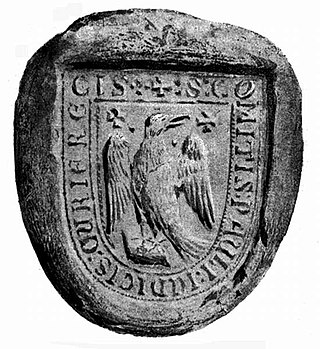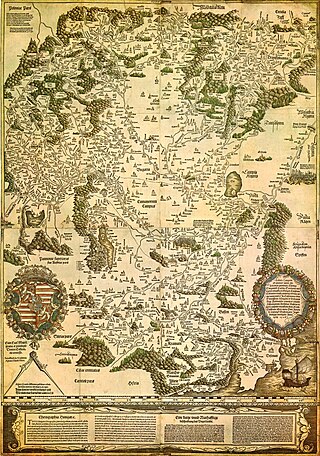Related Research Articles
Charles I, also known as Charles Robert, was King of Hungary and Croatia from 1308 to his death. He was a member of the Capetian House of Anjou and the only son of Charles Martel, Prince of Salerno. His father was the eldest son of Charles II of Naples and Mary of Hungary. Mary laid claim to Hungary after her brother, Ladislaus IV of Hungary, died in 1290, but the Hungarian prelates and lords elected her cousin, Andrew III, king. Instead of abandoning her claim to Hungary, she transferred it to her son, Charles Martel, and after his death in 1295, to her grandson, Charles. On the other hand, her husband, Charles II of Naples, made their third son, Robert, heir to the Kingdom of Naples, thus disinheriting Charles.

Joanna I, also known as Johanna I, was Queen of Naples, and Countess of Provence and Forcalquier from 1343 to 1382; she was also Princess of Achaea from 1373 to 1381.

The Capetian House of Anjou, or House of Anjou-Sicily, was a royal house and cadet branch of the direct French House of Capet, part of the Capetian dynasty. It is one of three separate royal houses referred to as Angevin, meaning "from Anjou" in France. Founded by Charles I of Anjou, the youngest son of Louis VIII of France, the Capetian king first ruled the Kingdom of Sicily during the 13th century. The War of the Sicilian Vespers later forced him out of the island of Sicily, which left him with the southern half of the Italian Peninsula, the Kingdom of Naples. The house and its various branches would go on to influence much of the history of Southern and Central Europe during the Middle Ages until it became extinct in 1435.

The House of Drugeth was a powerful noble family of the Kingdom of Hungary in the 14th to 17th centuries whose possessions were located in the northeastern parts of the kingdom. The ancestors of the family left Apulia for Hungary during the reign of King Charles I. Several members of the family held high offices in the first half of the 14th century and later, when the Drugeth estates were the largest in all of Hungary. The family continued to be important until the male line died out in 1691.

William Drugeth was a distinguished Neapolitan-born Hungarian baron and military leader in the first half of the 14th century. Along with his family, he was a courtier of Clementia of Hungary, Queen consort of France since his childhood. Upon the invitation of Charles I of Hungary, William arrived to Hungary in 1327, inheriting his uncle, Philip's wealth, who died without male descendants in that year. In the same time, William's father John Drugeth succeeded him as Palatine of Hungary.
Nicholas (VII) from the kindred Hahót was a Hungarian baron and soldier, who served as Ban of Slavonia from 1343 to 1346 and from 1353 to 1356; and Ban of Croatia from 1345 to 1346 and from 1353 to 1356. In this capacity, he played a key role in the restoration of the Hungarian suzerainty over Croatia. Also known as Nicholas of Alsólendva, he was the progenitor of the powerful Bánfi de Alsólendva noble family.
Stephen Sáfár de Csév was a Hungarian diplomat, soldier and noble in the first half of the 14th century, a loyal supporter of Charles I of Hungary and his consolidation efforts. In this regard, Stephen served as ispán of Pilis County and castellan of Visegrád Castle, simultaneously from 1318 until his death.
Peter, son of Petenye was a Hungarian lord at the turn of the 13th and 14th centuries. Initially a loyal supporter of King Charles I, he turned against the royal power and established a de facto independent province in Zemplén County after 1312, exploiting that political vacuum, which emerged following the dissolution of the Abas' dominion.

Paul Nagymartoni was an influential Hungarian nobleman and jurist in the first half of the 14th century, who served as Judge royal from 1328 to 1349.
Dominic (II) from the kindred Rátót was a Hungarian powerful lord at the turn of the 13th and 14th centuries, who served as Palatine of Hungary from 1315 to 1320. At the beginning of his career, he was a staunch supporter of Andrew III of Hungary, serving his Master of the treasury for a decade. He retained his office after the extinction of the Árpád dynasty too, during the short reign of Wenceslaus.
Ladislaus from the kindred Baksa was a Hungarian lord and soldier at the turn of the 13th and 14th centuries, who possessed landholdings in Zemplén County. Therefore, he had an important, although dubious role in the unification war of Charles I of Hungary against the oligarchic domains in Northeast Hungary. It is possible, he also served as (titular) ispán of Zemplén County from 1308 to 1321. Posthumously he was also known as Ladislaus Sztritei due to the family name of his descendants.

Philip Drugeth was a Neapolitan knight of French origin, who accompanied the twelve-year-old pretender Charles of Anjou to Hungary in 1300. After Charles I defeated his enemies in the struggle for the throne, Drugeth gained large-scale domains and held various ispánates in the northeastern parts of the kingdom, establishing there a semi-autonomous province. Drugeth integrated into the Hungarian nobility and is considered the founder of the powerful Drugeth family, which overwhelmingly dominated the royal court until the 1340s, but also continued to be important until the male line died out in the 17th century.

John (I) Drugeth was an influential Neapolitan–Hungarian baron, an early member of the powerful Drugeth family. He was a confidant of the Capetian House of Anjou since his childhood. While his younger brother Philip escorted his lord, the young pretender Charles of Anjou to the Kingdom of Hungary, John entered the service of Clementia, Queen consort of France and Navarre.

Nicholas (I) Drugeth de Gerény was a Neapolitan-born Hungarian baron and military leader in the first half of the 14th century. As a member of the prestigious Drugeth family, he arrived to the Kingdom of Hungary along with his father and brothers upon the invitation of King Charles I at the turn of 1327 and 1328. Nicholas entered the service of the royal court as one of the tutors of princes Louis and Andrew. In this capacity, he protected boldly the children during Felician Záh's unsuccessful assassination attempt in 1330. Thereafter, Nicholas served as Master of the cupbearers.
John (II) Drugeth de Homonna was a Neapolitan-born Hungarian nobleman. As a minor son of his namesake father, he arrived to the Kingdom of Hungary along with his family upon the invitation of King Charles I at the turn of 1327 and 1328, becoming the most powerful family in Hungary. However, the newly enthroned Louis I confiscated most of their wealth in 1342. John succeeded his brother Nicholas as the ispán of Ung County in 1354. John was the founder and first member of the Homonna branch of the Drugeth family. This remained the only surviving cadet branch of the family by the early 15th century, consequently all later Drugeths descended from John. The Drugeth family became extinct in 1684.

Drugeth Province is a modern historiographical term of a semi-official autonomous administrative division in the northeastern part of the Kingdom of Hungary.

Thomas Semsei was a Hungarian nobleman and soldier in the early 14th century. As a faithful confidant of Philip Drugeth, he served as vice-ispán of Szepes County and castellan of its namesake stronghold from 1315 to 1327. The Semsei family, which elevated to the rank of Count in 1907, descends from him.
Dominic from the kindred Csák was a Hungarian lord in the 13th century. Initially, he was a confidant of rex iunior Stephen, but later joined the partisans of the elderly Béla IV of Hungary. During the era of feudal anarchy, he served as a courtier of Queen Dowager Elizabeth the Cuman.

The Nagymartoni or Martinsdorfi was a noble family in the Kingdom of Hungary of Aragonese origin, which existed from the early 13th century to the mid-15th century. In the last period of their existence, they were subjects of the Duke of Austria too.
John Forrói was a Hungarian nobleman in the first half of the 14th century, who served as vice-ispán of Abaúj County in 1342.
References
- ↑ Hardi 2012, p. 354.
- 1 2 Hardi 2018, p. 58.
- 1 2 Hardi 2018, p. 59.
- 1 2 Zsoldos 2017, p. 74.
- ↑ Hardi 2012, pp. 144–146.
- ↑ Hardi 2012, pp. 308–309.
- ↑ Hardi 2018, pp. 53–54.
- ↑ Zsoldos 2017, pp. 200–201.
- ↑ Hardi 2012, pp. 360–361.
- ↑ Hardi 2012, p. 360.
- ↑ Hardi 2018, p. 56.
- ↑ Hardi 2012, p. 372.
- 1 2 Zsoldos 2017, p. 75.
- ↑ Hardi 2012, pp. 374–375.